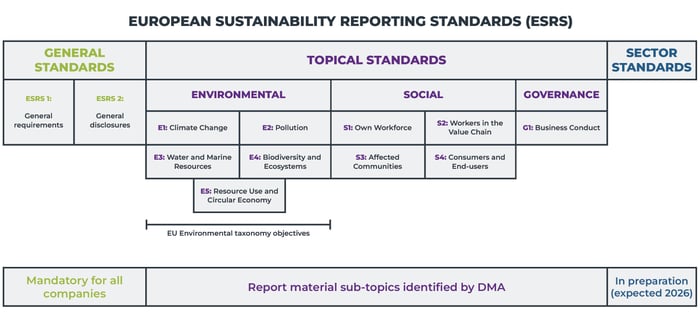
CSRD CONSULTING
The Corporate Sustainability Reporting Directive (CSRD) is transforming how companies approach sustainability reporting by setting higher standards for transparency, accountability, and comparability. At Tunley Environmental, we provide expert CSRD consulting services to help businesses navigate these requirements with confidence.


.jpg?width=100&height=62&name=Small%20Methods%20(2).jpg)
.jpg?width=100&height=62&name=Small%20Methods%20(1).jpg)
NAVIGATING CSRD REPORTING
The Corporate Sustainability Reporting Directive (CSRD) is an EU regulation designed to enhance and standardise sustainability reporting across companies operating in the European Union. It replaces the Non-Financial Reporting Directive (NFRD) and significantly expands the scope and requirements for sustainability disclosures.
Our CSRD consulting service aligns with European Sustainability Reporting Standards (ESRS), helping your organisation comply with the CSRD.
- Applies to all large companies (meeting two of the three criteria: more than 250 employees, €40 million+ in turnover, €20 million+ in total assets).
- Includes listed small and medium-sized enterprises (SMEs), though they are given extended timelines for compliance.
- Covers non-EU companies with significant operations in the EU (€150 million+ annual turnover in the EU and at least one subsidiary or branch in the EU).
- Companies must report on a wide range of ESG (Environmental, Social, and Governance) topics, including their impact on the environment, employees, human rights, and anti-corruption.
- Emphasises double materiality, meaning companies must disclose both the financial risks and opportunities of sustainability issues to the business and the issue's impact on society and the environment.
- The CSRD aligns with frameworks like the European Sustainability Reporting Standards (ESRS), Global Reporting Initiative (GRI), and Task Force on Climate-related Financial Disclosures (TCFD) to ensure consistency and comparability.
- Mandates digital tagging of reports in a machine-readable format to improve transparency and accessibility for stakeholders.
- Introduces mandatory third-party assurance of sustainability reports, ensuring accuracy and reliability of disclosed information.
TRANSFORM YOUR CSRD REPORTING
Get in touch and book your free consultation with our Sustainability Consultants.
WHY IS CSRD IMPORTANT

- Encourages transparency and accountability in corporate sustainability practices.
- Helps stakeholders, including investors, consumers, and regulators, make informed decisions based on standardised and comparable ESG data.
- Drives companies to integrate sustainability into core business strategies, promoting long-term resilience.
- It opens up trading opportunities with other organisations and customers around the world.
CSRD REGULATION TIMELINE
EU and EU enterprises already subject to NFRD reporting:
- More than 500 employees
- More than €50 million turnover
- Balance sheet of more than €25 million
2024-2025
Large enterprises
- More than 1,000 employees
- More than €50 million turnover
- Balance sheet of €25 million
2027-2028
No longer a mandatory requirement for SMEs. A voluntary standard is being developed.
Voluntary from 2026-2027
Large non-EU enterprises whose EU revenue exceeds:
- More than €150 million through a subsidiary or branch located within the EU
Delayed to 2029-2030
OUR CSRD CONSULTING SERVICE
- DMA Assessment
- E1: Climate Change
- E3: Water and Marine Resources
- E4: Biodiversity & Ecosystems
- E5: Resource Use and Circular Economy
Double Materiality Assessment
- Tunley Environmental will carry out a Double Materiality Assessment (DMA) with you to understand the areas that you will need to report on. We will produce a DMA report which will form the basis of your CSRD reporting efforts.
- The figure below demonstrates results of your DMA, forming the basis of your decision-making process.

Tunley is dedicated to conducting a comprehensive review of your ESG policies, identifying key topics and sub-topics that are material to your organisation. This can be extended to reviewing key stakeholders in the value chain, aiming to assess your wider impact beyond the company’s boundary.
Our expertise encompasses the design of both assessment and interpretational templates, as well as the creation and execution of surveys. We will develop customised surveys to be distributed to all stakeholders within your value chain, including employees, suppliers, customers, investors, and local communities where applicable (and other members). These surveys will gather valuable insights on the significance and impact of the various ESG sub-topics.
In addition to the surveys, Tunley can design and conduct interviews to ensure a comprehensive understanding of the topics that impact your company. These tailored interviews, conducted under CSRD guidelines, will provide nuanced insights and qualitative data to complement the broader survey findings. By integrating these insights into your DMA report, we enrich your CSRD compliance efforts with comprehensive and meaningful information.
Throughout the survey process, Tunley will also design an assessment template to evaluate the materiality of these factors in terms of their impacts on the environment, people, and the company’s financial undertaking. Upon completion of the surveys, our experts will meticulously analyse the results and apply them to the template. We will then present the data and findings to you in a formal report.
We will assist you by identifying areas of emissions, quantifying the size of the baseline, and establishing solution-focused targets and processes for carbon reduction. Using precise calculations that are peer-reviewed by our team of experts, we ensure accurate CSRD reporting on Scope 1, 2, and 3 emissions.
E1-1 Transition Plan for Climate Change Mitigation
We support organisations in creating structured, science-led Net Zero and transition plans, identifying high-impact areas for emissions reduction and providing credible decarbonisation pathways. These plans include baseline assessments, priority actions, timelines, and mitigation targets aligned with global frameworks such as SBTi and ISO 14064, forming a core element of your CSRD-aligned disclosure.
E1-3 Actions and Resources in Relation to Climate Change Policies
Our carbon accounting and strategy development services support the identification and implementation of clear actions and resource allocation in line with your climate objectives. We assist in documenting actions already underway, planned initiatives, and the organisational resources dedicated to each, ensuring compliance with E1-3 through transparent, evidence-backed disclosures.
E1-4 Targets Related to Climate Change Mitigation and Adaptation
We help you set ambitious yet achievable science-based targets across climate mitigation and adaptation, from short-term actions to long-term net zero goals. Our experts ensure targets are aligned with global expectations, underpinned by robust methodologies and regularly reviewed to track performance and drive progress, essential for meeting E1-4.
E1-5 Energy Consumption, Mix & Intensity Based on Net Revenue
We capture and analyse your energy use data to provide detailed insight into your energy consumption, mix (renewables vs non-renewables), and intensity metrics per net revenue. This supports a CSRD-aligned understanding of your operational energy impacts and informs your transition to a more efficient and sustainable energy model.
E1-6 Gross Scopes 1, 2, 3 Emissions & GHG Intensity
Our Carbon Accounting and Emissions Reporting service provides comprehensive Scope 1, 2, and 3 assessments in line with the GHG Protocol. We quantify emissions, calculate GHG intensity per net revenue, and provide third-party verification-ready outputs. We also develop strategies to manage and reduce Scope 3 emissions, which are often the largest and most complex to report.
E1-7 GHG Removals and Mitigation Projects Financed Through Carbon Credits
We evaluate your current or proposed GHG mitigation strategies, including the use of carbon credits, removals, or offset projects. Our scientists ensure these projects are transparently reported and aligned with best practices, clearly distinguishing between internal reductions and externally financed mitigation in accordance with CSRD requirements.
E1-8 Internal Carbon Pricing
While many organisations are just beginning to explore internal carbon pricing, our strategic support can help you assess feasibility, model carbon pricing impacts, and integrate pricing mechanisms into your climate transition planning. We help align internal incentives with emissions reduction goals, a growing expectation under CSRD E1-8.
E3-1 Policies Implemented to Manage Water and Marine Resource
Our services support organisations in shaping robust water and marine resource policies by providing deep insights into risks and impacts. The Water and Marine Biodiversity Risk Assessment identifies key operational, reputational, and regulatory threats, while the Water Footprint Assessment offers detailed data on usage and pollution. Together with the Supply Chain Marine Biodiversity Footprint Assessment, these services enable the development of science-informed policies that address both direct operations and upstream supply chain practices.
E3-2 Measurable Targets for Water and Marine Resources
By quantifying water-related risks, usage patterns, and marine biodiversity impacts, our services enable companies to set measurable and achievable targets. Risk assessments help prioritise high-exposure areas for action, while footprint assessments provide the benchmarks required to set and track reductions in water use, pollution, and marine ecosystem harm. These insights facilitate the creation of performance indicators aligned with CSRD expectations and broader sustainability commitments.
E3-3 Water and Marine Resources Action Plans and Resources
Our offerings provide a strong foundation for water and marine-related action planning. We equip businesses with the data and context needed to allocate resources effectively; whether to address operational risks, reduce water use, or influence supply chain behaviour. From local site plans to corporate strategies, our assessments support actionable steps that respond to identified risks and improvement areas, all traceable and transparent in line with E3-3 expectations.
E3-4 Water Consumption
The Water Footprint Assessment directly addresses E3-4 by quantifying water withdrawal, consumption, and discharge across operations. When combined with our water and marine biodiversity risk assessments, this provides not just the “how much” but also the “where and why,” taking into account local water stress and ecosystem sensitivity. This enables accurate monitoring, reporting, and benchmarking of water usage both within the organisation and throughout the value chain.
E3-5 Anticipated Financial Effects from Water and Marine Resources Related Impacts, Risks, and Opportunities
Our services help identify and evaluate the financial implications of water-related and marine biodiversity risks and opportunities. Whether through exposure to regulatory change, reputational damage, or physical scarcity, we highlight potential costs and savings, helping clients understand how environmental factors could affect long-term financial health. These insights align with CSRD disclosure requirements and support integration with broader frameworks such as TCFD.
We provide a structured and transparent approach to help organisations assess, strategise, implement, and maintain compliance with CSRD ESRS 4 biodiversity reporting expectations, ensuring they effectively disclose their biodiversity footprints, risks, and nature-positive actions.
E4-1 Transition Plan on Biodiversity and Ecosystems
We will provide a formal biodiversity transition plan, integrating science-based targets and aligning with the EU Biodiversity Strategy for 2030. The plan will show how we intend to move towards nature-positive outcomes and integrate biodiversity objectives into broader sustainability strategy, using the TNFD framework for structuring risks and opportunities.
E4-2 Policies Related to Biodiversity and Ecosystems
We will disclose our overarching biodiversity policy, showing alignment with stakeholder and environmental expectations, including biodiversity safeguards in procurement. Policies will be reviewed for alignment with TNFD principles and double materiality under CSRD.
E4-3 Actions and Resources Related to Biodiversity and Ecosystems
We will report on site-level and supply chain biodiversity activities, restoration efforts, and nature-based solutions. Resource allocation (e.g. staff, budget) will be described to show operational support for biodiversity. Our Supply Chain Biodiversity Footprint (SCBF) will form a key part of this disclosure.
E4-4 Targets Related to Biodiversity and Ecosystems
We aim to establish measurable biodiversity targets linked to our transition plan. These will be reported using the SBTN framework and incorporated into our broader sustainability metrics and annual ESG reporting.
E4-5 Impact Metrics Related to Biodiversity and Ecosystems Change
We will report biodiversity impacts across our value chain using footprinting methodologies and LCIA approaches. Site-level impacts will be supported with spatial mapping of biodiversity sensitivity, using geospatial tools where applicable.
E4-6 Potential Financial Effects from Biodiversity and Ecosystem-Related Impacts, Risks and Opportunities
We will identify and disclose financial risks and opportunities arising from biodiversity issues, including nature-related dependencies and transition risks. Our double materiality assessment will guide prioritisation of key topics and inform future financial disclosures aligned with TNFD recommendations.
Resource Use and Circular Economy goes beyond compliance, helping organisations translate regulatory requirements into measurable business benefits. Read more information on Circular Economy Assessments.
E5-1 Policy Development
We support the creation and disclosure of circular economy policies that align with CSRD E5 and EU Circular Economy principles, embedding sustainable resource management into your core strategy.
E5-2 Action Planning
Tunley helps shape practical circular initiatives, mapping resources, stakeholders, and value-chain boundaries to reduce waste and encourage material regeneration.
E5-3 Target Setting
Together, we establish measurable targets for resource reuse, waste reduction, and regeneration, integrating them into sustainability KPIs and science-based frameworks.
E5-4/E5-5 Resource Flow Analysis
Our circular economy assessment quantifies material inflows and outflows, highlighting opportunities to increase renewable, recycled, or reused inputs while improving product durability and recyclability.
E5-6 Waste Management
We evaluate waste generation, recovery, and disposal through an ESRS E5-aligned lens, helping you enhance transparency and track circular performance.
E5-7 Resource Optimisation
Tunley identifies interventions that retain resource value through reuse, remanufacturing, and efficiency gains, advancing your sustainable resource management goals.
E5-8 Circular Partnerships
We integrate supply chain management collaborations that promote circularity, including repair networks, product-as-a-service, and shared-use circular business models that encourage long-term sustainability.
E5-9 Financial Insight
We assess the cost implications, risks, and opportunities of circularity, turning your CSRD E5 reporting into a financial and strategic advantage.

DOWNLOAD OUR CSRD STEP-BY-STEP CHECKLIST
Whether you're just starting your journey or refining your ESG strategy, our CSRD Checklist provides a clear, step-by-step guide to help your business meet new regulatory requirements with confidence.
From start to finish the whole team have excelled in communication and support. They made the entire process seemless, and nothing was too much for them. This is my first full experience completing a carbon assessment, and I couldn't have asked for a better company to complete this with.”
Rebecca Druce
SQE Manager | Spacecare
They did exactly what was asked and where we had less than perfect understanding of the issues involved their expertise showed through. The response time to follow up enquiries was excellent and I would happily use Tunley again.”
Michelle Smith
Intellectual Property Controller | Power Roll
The team were so helpful and made this project so easy and painless. The communication was well executed and the requests were clear. I would 100% recommend working with Tunley Environmental, for all your sustainability reporting.”
Louise Ewer
Operations Director | Wunder-Bar Dispensing
We used Tunley Environmental to help us with out carbon reduction targets, they conducted an embedded carbon report for one of our key ranges and we are now exploring next steps. I would highly recommend them professional, helpful a great company to work with”
Kieron King
Quality Manager | Inpress
We found all of the Tunley Environmental representatives to be extremely friendly, helpful and knowledgeable. They provided a high standard of service with plenty of advice and support, including regular meetings to update on progress and present findings. We look forward to working with Tunley Environmental again on future projects.”
Mary Bellamy
Lead Research Nurse | University Hospitals Birmingham NHS Foundation Trust





WHY CHOOSE TUNLEY?
Our team of sustainability professionals combines scientific rigor with real-world experience in environmental consulting.
We provide industry-specific solutions for businesses of all sizes and sectors.
With experience in international compliance standards, we help companies meet CSRD requirements across boarders.
Tunley Environmental has a track record of delivering measurable sustainability results for diverse clients.
OUR PhD SCIENCE TEAM
-1.jpeg?width=300&name=Tunley%20Headshots%20(3)-1.jpeg)
-1.jpg?width=300&name=Tunley%20Headshots%20(25)-1.jpg)
.jpg?width=300&name=Tunley%20Headshots%20(14.1).jpg)
.jpg?width=300&name=Tunley%20Headshots%20(16.1).jpg)
.jpg?width=300&name=Tunley%20Headshots%20(26).jpg)

.jpg?width=300&name=Tunley%20Headshots%20(24).jpg)
.jpg?width=300&name=Tunley%20Headshots%20(13.1).jpg)


INSIGHTS OF INTEREST

The growing conversation around circular economy and carbon reduction is reshaping how industries approach sustainability, especially as businesses grapple with rising Scope 3 emissions and tightening regulatory expectations.
Read The Insight
Guidance for ESG managers on implementing DMA to align with CSRD and ESRS, using EFRAG's 6-step materiality process.
Read The Insight
The directive outlines specific requirements for what companies need to report, including the impact of their operations on the environment and society...
Read The Insight.jpg?width=300&name=group-of-team-creative-business-people-join-hands-2025-02-18-20-37-26-utc%20(1).jpg)
Learn how to conduct a DMA to understand the interaction between a company's operation performance and the environment.
Read The Insight
Discover the latest updates on CSRD and how businesses can prepare for new reporting requirements starting in 2025.
Read The Insight
Learn how to prepare for CSRD with our comprehensive step-by-step guide, covering compliance requirements, timelines, and key strategies for success.
Read The Insight
To effectively navigate the full implementation of the CSRD, it is important to first understand what has changed in its scope, timeline and how to prepare your organisation for compliance.
Read The Insight
Discover the key differences between CSRD and NFRD, and how businesses can adapt to the new, more rigorous EU sustainability reporting standards.
Read The InsightFREQUENTLY ASKED QUESTIONS
CSRD applies to large companies and certain listed SMEs operating in the EU. Compliance depends on company size, listing status, and sector, with phased implementation dates, so businesses should start preparing early to meet reporting obligations.
Financial materiality – how sustainability issues, such as climate change or biodiversity loss, could impact the company’s financial performance.
Impact materiality – how the company’s activities affect the environment and society.
This approach ensures that CSRD reporting provides a complete picture of risks, opportunities, and impacts.

